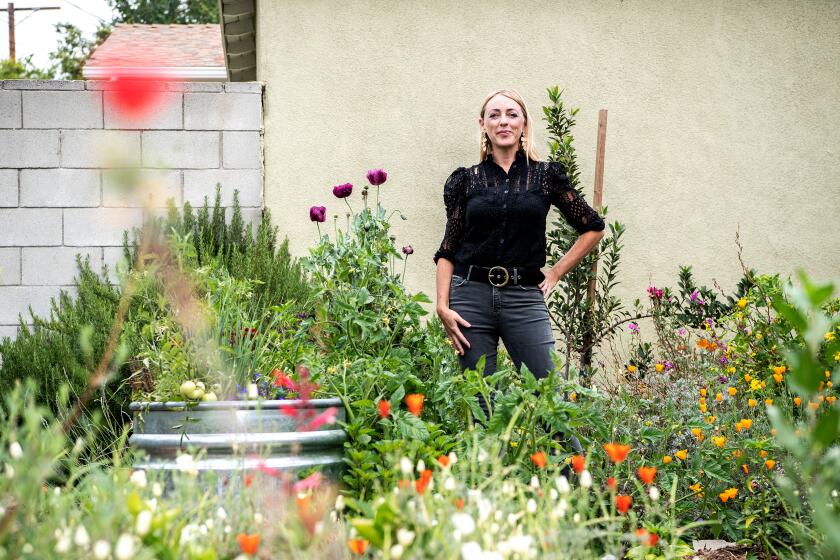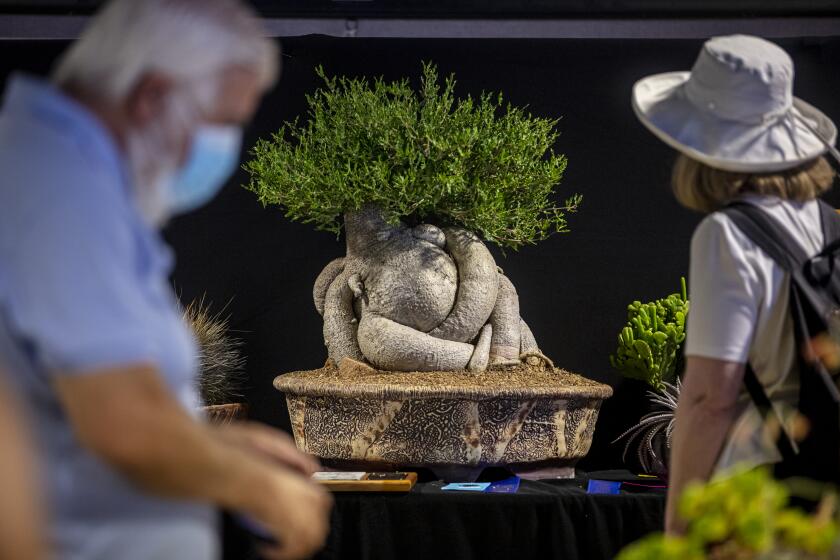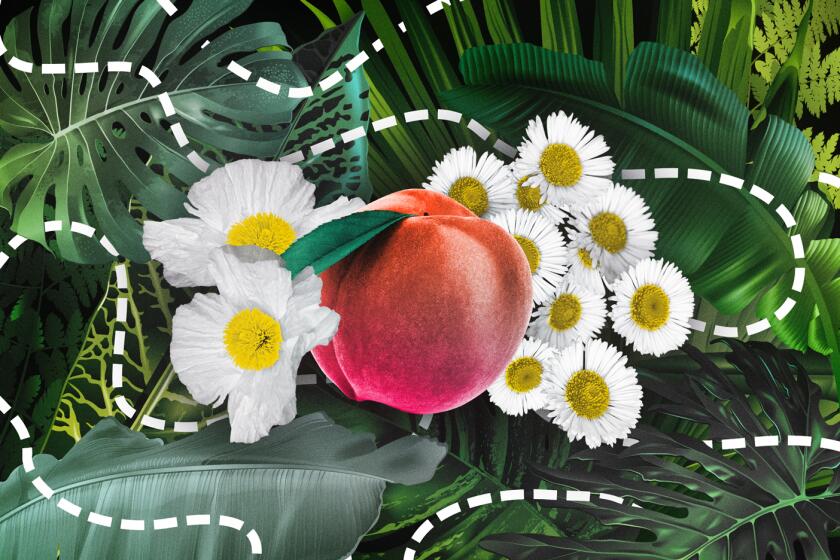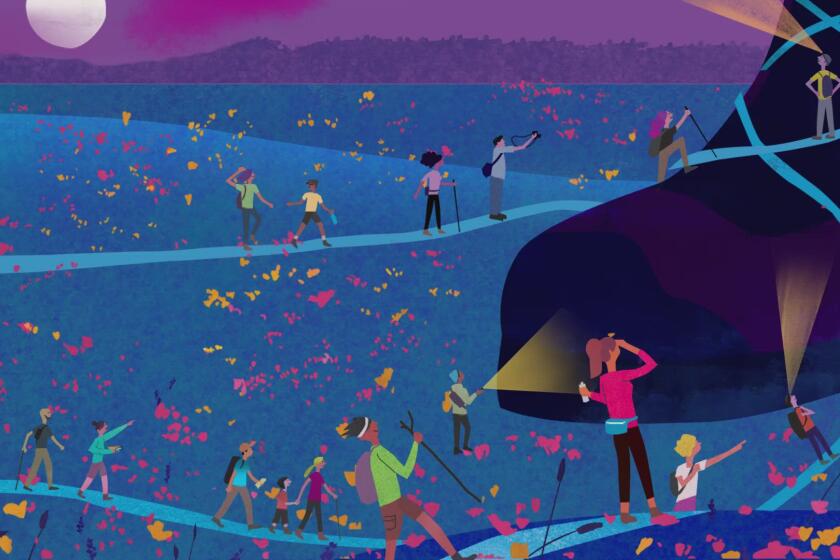If we’re trying to really fight climate change and mass extinctions, the whole natural world needs to be part of the conversation, especially in urban areas, says native plant horticulturist Katherine Pakradouni.
That’s where her concept of micro forests comes in — plots of land as small as 10 by 10 feet devoted to dense, multilayer plantings of Indigenous shrubs and trees that serve as “kind of complete ecosystems and biodiversity magnets.”
These micro forests are particularly important in urban areas — on school grounds, perhaps, or park perimeters or even part of someone’s yard — because insects, birds and other wildlife are rapidly running out of places to live, said Pakradouni, manager of the National Park Service nursery growing native plants for a wildlife crossing under construction that is meant to help animals safely cross the 101 Freeway in Agoura Hills. Trees are vital for shading and cooling city dwellers, but they’re also key to habitat building.
“Cities aren’t just for people — there is no space left anymore that should be just for people.”
“Micro forests mean survival for animals who wouldn’t have made it without these little plots in public places,” said Pakradouni. “Cities aren’t just for people — there is no space left anymore that should be just for people. We need to realize that our well-being is completely dependent on the health of other creatures. Micro forests are all about humans supporting other life and helping them navigate our built environment.”
Learn more about micro forests
When: Aug. 11 at 7 p.m.
Where: Friendship Auditorium at 3201 Riverside Dr. in Griffith Park
Cost: Free
Pakradouni designed and built L.A.’s first micro forest at Griffith Park for the Los Angeles Parks Foundation with funding from the Hancock Park Garden Club. She is discussing that project and the micro forest technique she adapted from Japanese botanist Akira Miyawaki’s afforestation method during the Southern California Horticultural Society meeting on Aug. 11 in the Friendship Auditorium at 3201 Riverside Drive in Griffith Park. The meeting starts at 7 p.m.; Pakradouni’s talk is at 7:30. Admission is free, but you can also watch online via Zoom with pre-registration.
Miyawaki introduced his method for planting Indigenous micro forests in the 1970s for more temperate or tropical climates. Pakradouni adapted his method for Southern California’s Mediterranean climate, using plants native to the region.
The circular micro forest in Griffith Park’s Bette Davis Picnic Area was completed in 2021, said Pakradouni, filling about 1,000 square feet with four layers of native plants, including coast live oaks, a keystone species for California because it supports a wide variety of insects and other wildlife; smaller trees such as elderberry and California laurel, shrubs like toyon, lemonade berry and California wildrose, and low-growing perennials like mugwort.
Pakradouni said the trees and shrubs are planted randomly in the small spaces, mixing plants of various heights into a dense thicket that shades the soil and creates habitat for wildlife. Just a year after the Griffith Park area was planted, she said the micro forest is full of insects, who attract birds, lizards, squirrels and even toads who migrated from the Los Angeles River below, up an embankment and over a horse trail “because there were enough bugs for them to eat and holes made by ground squirrels to protect them from the heat.”
The dense thickets of a micro forest don’t conform with our traditional landscaping idea of a single tree growing over a leaf-less lawn , but they are perfect habitat for birds who often nest or search for food on or near the ground. Baby birds don’t usually start flying from high nests, she said; they learn to fly from the ground up, “so unless they are protected by shrubbery under trees, they are tasty snacks for predators.”
If you can create a micro forest in your yard or school grounds, it’s important to remember that leaf litter and fallen branches are important parts of the habitat. “We seem to have this unfortunate idea that dense shrubs, branches and leaf litter are unsightly, but it could literally mean life or death for many species.”
We must change the way we think about aesthetics in our landscaping, she said. “Beauty should be measured by how much life something is supporting, not the old English manor model, which is a poor fit for here anyway.”
Pakradouni is creating a website — lamicroforests.com — to provide step-by-step instructions for creating a micro forest in Southern California, but it likely won’t be completed until the end of August. In the meantime, if you’ve got at least 100 square feet in your yard and want to create a micro forest, she recommends the following:
- Make sure your space can support at least one native oak tree, which can grow 25 to 80 feet tall. “If you don’t have space for at least one oak tree, this isn’t the method for you, but you can do any other fantastic native landscape.”
- Choose at least one smaller tree, like elderberry, California black walnut or laurel, plus berry-rich shrubs like toyon and low-growing or groundcover plants like mugwort to grow under and around the oak tree. Elderberries and the shrubs grow more quickly than the oak, but over time the oak will come to dominate the space.
- Resist the urge to rake up leaf litter and branches in your micro forest because it provides valuable shelter and food, especially for insects and birds. The smaller twigs provide materials for bird nests and the decomposing leaves help enrich the soil. This is particularly important for schools, where the debris on the ground can become a tiny laboratory for students learning about seasons, plant life cycles and habitat for insects and other creatures.
- Plan and prep for your micro forest now but wait until late fall or winter to plant for best success.
- If you haven’t got space on your property, lobby for and/or help create micro forests in public spaces like schools or parks.
- You’ll never need to mow or blow again in your micro forest. And once established, these plants need almost no water besides winter rain ... which ideally will someday return.
Looking for other plant-related things to do in August? Check out our list below. Email events to [email protected] at least three weeks before they happen, and we might include them in the calendar:
Aug. 5-7
2022 Inter-City Cactus and Succulent Show & Sale features more than 1,400 rare and unusual plants on display and for sale at the Los Angeles County Arboretum, 301 N. Baldwin Ave. in Arcadia. The sale, which starts Aug. 5, features 20 vendors from 9 a.m. to 5 p.m. through Aug. 7. The show, featuring entries from beginners to professionals, is Aug. 6 and 7 from 9 a.m. to 5 p.m. Admission is free with a ticket to the Arboretum. Arboretum members enter free, but nonmembers must purchase their tickets in advance online for $15 ($11 for seniors 62 and older and students with ID, $5 for children 5 to 12. Children under 5 enter free.) intercityshow.com
Aug. 6
South Bay Bromeliad Associates’ Show and Sale runs from 10 a.m. to 4 p.m. at the Palos Verdes Art Center, 5504 Crestridge Road in Rancho Palos Verdes. South Bay Bromeliad Associates members will be displaying their own bromeliads, including specimens of tillandsia, neoregelia, dyckia, vriesea, aechmea, billbergia and guzmanias. The sale will include plants from Southern California vendors and members. Parking and admission is free. pvartcenter.org
Pruners, loppers and keyhole saws — a free tutorial in their best uses and keeping them sharp by the UC Cooperative Extension Master Gardeners of Orange County, 10 to 11 a.m. at the Orange county Great Park Farm + Food Lab, 14280 Cadence St. in Irvine. The class is free, but online registration is required. Look under “Garden Workshops.” mgorange.ucanr.edu
Monarch Nature Trail Volunteer Day runs 9 to 11 a.m. at 5302 Rancho Road in Huntington Beach, sponsored by the UC Cooperative Extension Master Gardeners of Orange County. Volunteer tasks are available for all ages, including watering, seed collection, mulching and weeding. Participants are advised to wear closed-toe shoes, a hat and sunscreen and bring drinking water. Note that no restrooms are available on site. mgorange.ucanr.edu
Experience the Flavors of California Native Plants, a free talk — with samples! — by native plant enthusiasts Krystal Rains and Joe Parker about regional drought tolerant native plants that are edible, 10 to 11 a.m. at the Altadena Main Library, 600 E. Mariposa St. Meet on the front lawn at the library’s native plant garden. altadenalibrary.org
Aug. 6-7
Orange Empire Bonsai Society Bonsai Show includes displays of miniature trees grown by members both days 10:30 a.m. to 4 p.m., and free drop-in sessions on Aug. 7 discussing what kinds of tree species can be used to create a bonsai, at 11:30 a.m., and how to create miniature accent plants for bonsai at 1 p.m. Entry to the show is free with $5 admission to the garden (members and children 3 and under enter free). thesherman.org
Aug. 6, 13, 20 and 27
Santa Monica Mountains Fund Native Plant Nursery Volunteer Days at the Rancho Sierra Vista Nursery, which grows native plants for restoration projects in the Santa Monica Mountains, 9 a.m. to 2 p.m. at the nursery, in the Rancho Sierra Vista Recreation Area, 4803 Lynn Road in Thousand Oaks. Park at the Sycamore Canyon car park on Via Goleta. Volunteers should arrive before noon; those who work at least two hours transplanting seedlings, dividing local grasses, sowing seed flats, processing cuttings, watering and/or fertilizing get three free native plants to take home. samofund.org
Home Composting & Urban Gardening, free workshops in composting sponsored by LA Sanitation from 9 to 11 a.m. at the Gaffey Nature Center, 720 W. Summerland Ave. in San Pedro on Aug. 6, the South L.A. Wetlands, 5413 S. Avalon Blvd. in South Park on Aug. 20 and Lopez Canyon Environmental Education Center, 11950 Lopez Canyon Road, on Aug. 27. (The Aug. 13 workshop at Griffith Park Composting Facility, 5400 Griffith Park Drive, is already full.) L.A. city residents with proof of address can purchase compost bins and worm bins for $20 and “wing diggers” — compost aeration tools — for $8 at the workshops, while supplies last. Free mulch and compost are also available at all locations. Workshops are free, but advance registration is required. lacitysan.org
Aug. 9
How to grow herbs in containers, a free walk-in class taught by the UC Cooperative Extension Master Gardeners of Orange County from 5 to 6 p.m. at the Cypress Library Community Room, 5331 Orange Ave. in Cypress. mgorange.ucanr.edu
Aug. 10
Comprehensive Irrigation for California Native Plants, a class taught by Tim Becker, the Theodore Payne Foundation director of horticulture, from 9 a.m. to noon at the foundation’s nursery, 10459 Tuxford St. in Sun Valley. Classroom instruction is followed by a field walk and review of the foundation’s irrigation systems. Students will leave with a comprehensive resource guide. $65 ($55 for members). Register online. eventbrite.com
Aug. 12
How to create a wildlife habitat in your backyard, a free walk-in class taught by the UC Cooperative Extension Master Gardeners of Orange County from 5:30 to 6:30 p.m. in the Anaheim Library Community Room, 500 W. Broadway. mgorange.ucanr.edu
Aug. 13
Reconnecting People and Plants: A Learning Walk in Pasadena that explains how plants can be medicine, led by Therese Richau, a member of the Gabrieleno Band of Mission Indians and owner of Native Roots soaps and balms, and Poly/Ana, the nonprofit community service arm of the Studio Petrichor landscape designers, 8:30 to 10:30 a.m. in Pasadena foothills. Directions to the start of the hike will be sent to registered participants three days before the hike. $35, register online. eventbrite.com
Aug. 13 & 18
Managing pests in your garden, a free walk-in class taught by the UC Cooperative Extension Master Gardeners of Orange County from 11 a.m. to noon at the Shipley Nature Center, 17851 Goldenwest St., in Huntington Beach on Aug. 13 and 5 to 7 p.m. at the Sunkist Branch Library, 901 S. Sunkist St. in Anaheim on Aug. 18. Learn multiple ways to effectively control garden pests using the least toxic methods. mgorange.ucanr.edu
Aug. 16
Summer evening stroll through the Fullerton Arboretum, from 6:30 to 8 p.m. at 1900 Associated Road, Fullerton, features free nonalcoholic refreshments and live music by students from the California State University, Fullerton School of Music. Members enter free with advance reservations; nonmembers can buy $10 tickets at the gate. fullertonarboretum.org
Aug. 20
Adult Night Hike: Bizarre Botany explores the strange and fascinating plants in the Los Angeles County Arboretum’s collection, 7:30 to 9 p.m. Advance registration required online, tickets include admission to the garden, so you can wander the grounds before the hike begins. $25 ($20 members) arboretum.org
Gardening in Small Spaces, a free walk-in class taught by the UC Cooperative Extension Master Gardeners of Orange County from 5 to 6 p.m. at the Shipley Nature Center, 17851 Goldenwest St., in Huntington Beach. Learn tricks to creating and caring for a small but welcoming garden space using ornamental plants. mgorange.ucanr.edu
Aug. 25
Grow Food Anywhere, a free walk-in class taught by the UC Cooperative Extension Master Gardeners of Orange County from 6 to 7 p.m. at the Yorba Linda Library Community Rooms, 4862 Lakeview Ave., in Yorba Linda. The class outlines the pros and cons of the various places to grow vegetables, fruits and herbs, as well as explanations about integrated pest management, fertilizing and harvesting. mgorange.ucanr.edu
Aug. 27
Growing Water Wise at California Botanic Garden: Introduction to Garden Design for California Native Plants, a class taught by Krista Von Stetten, a native plant garden designer, from 9:30 to 11 a.m. at the California Botanic Garden, 1500 N. College Ave. in Claremont. Learn the fundamentals of how to design a native plant garden in harmony with your site conditions. Register online, $30 ($25 members). calbg.org













